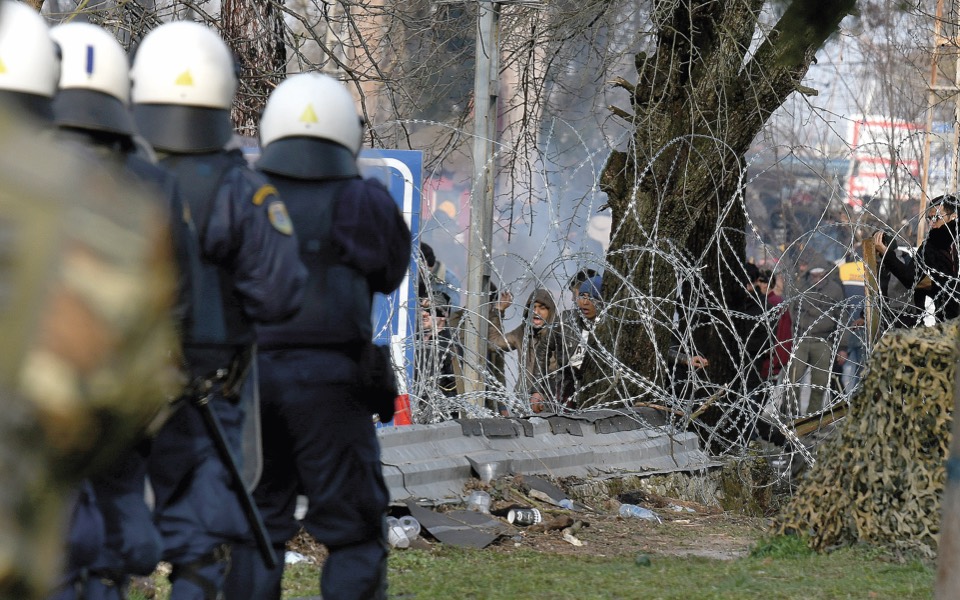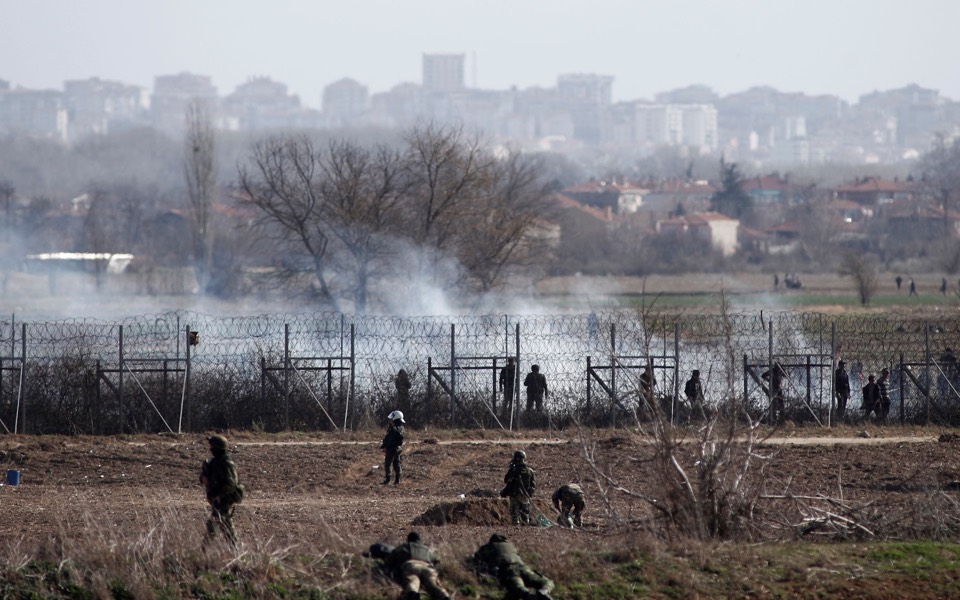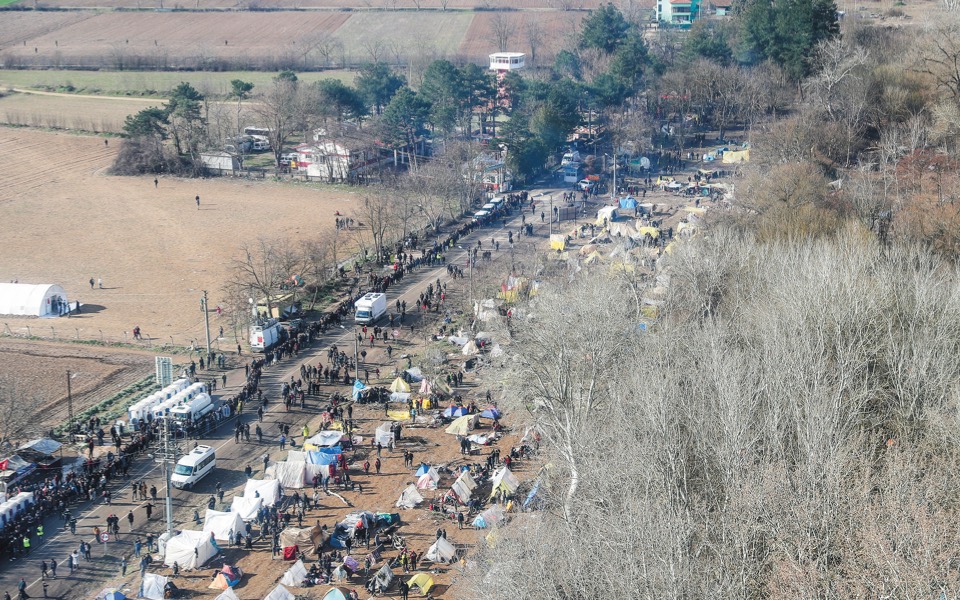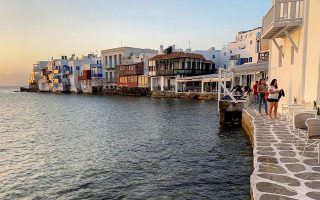‘We fought man-to-man’ to hold the Evros border
A year on, two protagonists of successful effort to prevent 2020 push by thousands of migrants at Greek-Turkish frontier talk about the operation

A year after a failed attempt by thousands of undocumented migrants and refugees to force their way into Greece through its northeastern land border with Turkey, the Evros frontier has evolved into an almost impenetrable European fortress.
The heroic efforts of a handful of border guards and police officers at the Kastanies customs post on the night of February 28, 2020 succeeded in thwarting what was essentially an effort by Turkish President Recep Tayyip Erdogan to breach Greece’s border, using migrants as his battering ram. The successful quashing of the push also alerted the European Union to the threat on its external border, prompting top officials from Brussels to visit the area, on the initiative of the Greek prime minister, just a few hours after the attempted invasion was stopped.
Evros has undergone a rapid transformation in the wake of those events. Apart from new steel fences, electronic surveillance systems and specially trained Greek and European guards, Evros has also been bolstered geopolitically by the selection of nearby Alexandroupoli port for NATO military operations, as an alternative to the Bosporus Strait, for the transport of cargo by rail to the Black Sea and for the construction of a fuel pipeline supplying Alliance forces in the Eastern Mediterranean.
In fact, Turkish media made no secret of Ankara’s annoyance with NATO’s recent use of Alexandroupoli to bring in forces and troops participating in the huge Defender 21 exercises in Romania and Bulgaria.
The conversation may have been much different today, however, if Erdogan’s “hybrid army” of irregular migrants had made it through Kastanies just a year ago. It would have been a public relations disaster for Greece – which would have appeared incapable of defending its border against a few hundred unarmed civilians – and a boon for Erdogan, while the political instability it would have signaled in Greece would have steeped the country in crisis.
Two of the unsung heroes who helped hold the border at Kastanies, police sergeants Panagiotis Harelas and Dimitris Derventlis, spoke to Kathimerini recently of how a handful of guards managed to prevent the violent push.
“We fought man-to-man, we doled out and endured a lot of thrashings, but we held out and our defense in those first few hours altered the course of events,” says Derventlis.
“It was tough, but we were emboldened by a sense of duty and the bravery of our superiors who stood on the frontline giving orders even though they were also being pelted with rocks,” he adds.
Unhindered
Friday, February 28, was the eve of the Greek Carnival season. The Kastanies customs checkpoint was operating as usual and cafés, bars and tavernas in the town of Orestiada were getting ready to welcome the usual influx of secular Turks from neighboring Edirne, looking for a good night out.
Harelas showed up for work at 5.30 a.m. at the Didymoteicho police precinct, when the officer he was relieving from duty reported that thermal cameras had picked up some unusual activity on the other side of the border, near the Kastanies crossing. Two hours later, he got a telephone call ordering him to lock up the police station and rush over to Kastanies as fast as he could.
“The first wave from the Turkish side was already attempting to cross the area in front of the guard post, which was being defended by about a dozen colleagues and as many soldiers who had parked a bus at the entrance to stem the flow,” says Harelas. It was an uneven battle in terms of numbers, he adds, remembering how many of the younger migrants tried to get through via the dense forest which just four or five people were able to patrol.
“At around 9 a.m., quite a large number of young men appeared in the ‘dead zone’ and moved toward us. The Turkish guards did nothing to stop them and they came, cool and nonchalant, as though they were out for a stroll. A senior Turkish officer told them that they could not cross into a foreign country without legal papers and asked them to leave. Not only did they ignore him, but more people started appearing… and then even more, until there were several hundred,” explains Derventlis.
“That’s when the clashes started – and they were fierce. Man-to-man fighting, hails of stones. There was violence from both sides, but we held out as long as needed, until backup could arrive,” he adds.
“It is true that we were taken by surprise at first, almost caught napping, and about 30 of them managed to get in through the woods, but most were later arrested by patrols. But we reacted fast, and at some point during a brief hiatus, the guys from the military guard were able to lay out razor wire so our defense was significantly strengthened. The second big push came at around 3 p.m. by more than a thousand young men who, having the cameras of Turkish and foreign news agencies looking on, attacked with particular violence. The Turks obviously allowed the cameras ahead of the push so they could broadcast the fall of the Greek border,” comments Harelas.
All hands on deck
The push marked the beginning of a Turkish-Greek border crisis that could have escalated dangerously, depending on Turkey’s plans, and brought the two countries to the brink of war. Police and military forces were deployed to Kastanies from across northern Greece, while buses packed with riot squads were dispatched from Athens.
“All available resources were sent to Kastanies as fast as possible – even fellow officers who were off duty rushed to help us,” says Derventlis.
Until the first batch of backup could arrive, a specially trained negotiator was sent in to speak with the angry protesters, telling them that they had to calm down so a compromise allowing them to pass into Greece could be achieved. What he was actually doing, in fact, was trying to buy some much-needed time for the Hellenic Police (ELAS) and the military to send reinforcements.
Help arrived at around noon on Saturday, amassing at so-called “ground zero,” right on the crossing and along the length of the border fence. The threat of a massive incursion had been staved off, but it had not disappeared.
Seeing the soldiers and police on the Greek side of Kastanies, the migrants split up into groups and started making their way west to the section of the fence at Nea Vyssa and north to the forest of Marasia, hoping to bypass the blockade.
“That’s when another battle broke out,” says Derventlis. “To our left, meanwhile, we had a squad of commandos brought in from Drama – as per the plan – while military patrols along the fence were increased and the riot officers were dispatched to prevent any crossings.”
The skirmishes at Kastanies lasted into the early hours of Sunday but Greece’s defenses were solid.

“They changed tactics the next day. They put the women and children first, followed by the television crews, with the younger men bringing up the rear in groups armed with stones, sticks and smoke bombs that had been supplied by the Turkish authorities, making dashes at the customs crossing, at the fence and further south. The fire service’s water cannon was right behind us at the blockade, shooting tons of water at the gathered mob. It was terrifying for them because when the temperature is below zero and you’re being soaked to the bone, all you think about is how you’re going to stay dry. That water cannon worked wonders.”
Further along, another water cannon was dousing anyone who got near the fence on the Turkish side with dyed water, which was another component of the so-called “Operation Influence.”
“It makes the enemy panic because he doesn’t know how he will be affected by the dye, but also frightened because he’s marked as having been involved in the riot,” Christos Drivas, a retired general and expert in psychological warfare, told Kathimerini.
The outcome of the battle had been determined from the moment that reinforcements arrived and carried on the work of the first line of defense; nevertheless, the skirmishes continued for several days, especially along the river.
Local support
Behind the official front line of defense, another powerful preventive force started to muster from the very beginning of the border crisis. Local men and women, as well as children and seniors, stepped forward at the first sign of trouble, displaying incredible heroism, and playing a crucial role in propping up the border’s defenses.
Farmers in tractors patrolled the river night after night, reporting any suspicious activities to the authorities. At the Evros Delta, fishermen and hunters patrolled little-known passages, while local women distributed food to the soldiers and police officers and sewed and distributed masks to guard against the coronavirus, while the elderly helped collect money, as help arrived from across Greece.
While a handful of incidents of extreme behavior were reported, by no means did they define the overall response from the community.
Communications war
The communications war that accompanied the battles at the border was almost as fraught. The Turkish propaganda machine, which had sought to portray Greece’s border as a leaky, defenseless sieve, shifted gear after the initial push at Kastanies failed.

It started feeding digital media and foreign correspondents at the border with “news” and “information” that cast the Greeks as nothing less than murderers of civilians. The objective was obviously to turn international public opinion against Greece and to portray the botched invasion as a guileless attempt by a few thousand desperate asylum seekers, so as to shift attention away from the fact that the migrants were being exploited and weaponized by Ankara. The European officials who visited Evros with Prime Minister Kyriakos Mitsotakis were not fooled though.
On the Greek side of the border, officers with bullhorns transmitted the message in at least four different languages to the migrants camped on the other side that their attempt to break through was illegal and would have consequences. They wanted the message to make its way to the thousands camped further away, waiting for the border to fall so they could rush through.
At the end of the day, Greece won the “Battle of Evros” on the ground and Turkey suffered a loss of credibility. The coverage around the world was unflattering for Greece though, as it mainly consisted of emotionally charged reports, with little of the big picture, and accusations by nongovernmental organizations and human rights groups.
Nevertheless, there were those who argued that, despite the harsh and perhaps unfair depiction of events, Greece benefited from the fact that the events of February 28, 2020 showed that it wasn’t kidding.
Angry atmosphere
One year on, the people of Evros are up in arms again, albeit for a different reason. Plans to enlarge the migrant identification and reception center at Fylakio, near Orestiada, and to transfer several thousand asylum seekers from other facilities have met with vehement reactions. Locals across the region have vowed to oppose the plan by any means possible.
Migration Minister Notis Mitarakis felt their ire during a recent visit to Orestiada, where he was met with insults and protest chants.
“Not all of us who are speaking out against the plan are far-right supporters, but this is an issue of national security. Don’t they get that in Athens?” Fani Bacharidou, a resident of Nea Vyssa in Orestiada, said in comments to Kathimerini.





